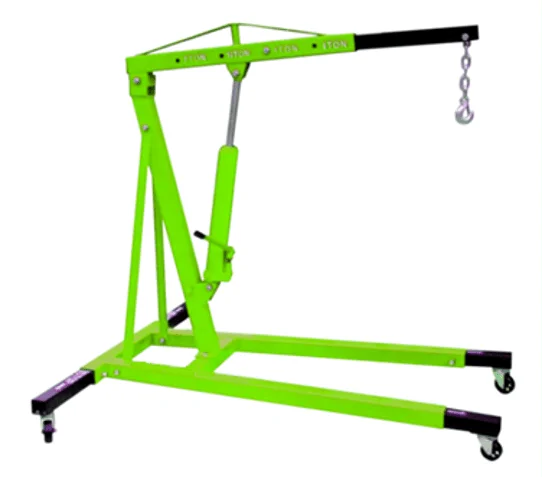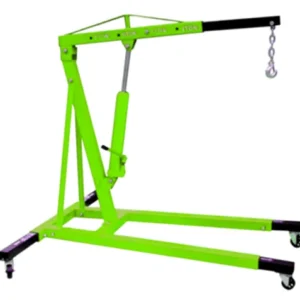Are you in need of a reliable shop crane for your heavy lifting needs? Look no further than our ultimate guide, designed to help you choose the perfect crane for your specific requirements. With our expert advice and in-depth analysis, you’ll be able to make an informed decision that meets all your lifting needs. Whether you’re working in the automotive industry, construction, or any other field that requires heavy lifting, having the right shop crane is essential. It not only ensures safe and efficient lifting but also improves productivity and eliminates the risk of accidents. In this comprehensive guide, we’ll walk you through the key factors to consider when choosing a shop crane. From lifting capacity and height range to stability and durability, we’ll cover all the important aspects you need to know. We’ll also highlight different types of shop cranes available in the market, their pros and cons, and provide recommendations to make your decision-making process easier. Don’t compromise on safety or efficiency, let our ultimate guide help you find the perfect shop crane for your heavy lifting needs.
Understanding Shop Cranes
Shop cranes, also known as workshop cranes or floor cranes, are versatile lifting devices designed for light-duty applications. They provide a cost-effective solution for lifting heavy objects within confined spaces. These cranes typically consist of a steel bridge that moves along parallel tracks, allowing efficient material handling.
GET IT NOW
Key Features and Benefits
- Load Capacity and Safety Factors:
- When selecting a shop crane, which comes in various load capacities ranging from a few hundred kilograms to several tons, it’s essential to consider the maximum weight you’ll need to lift.
- Factor in safety margins when choosing a crane. It’s advisable to select a crane with a slightly higher capacity than your typical load requirements.
- Boom Extension and Reach:
- The adjustable boom allows you to customize the lifting height and reach. Longer booms are useful for reaching objects in tight spaces or elevated areas.
- Consider the specific tasks you’ll perform. A telescopic boom provides versatility for different lifting scenarios.
- Materials and Durability:
- Look for shop cranes made from robust materials such as steel. High-quality construction ensures longevity and resistance to wear and tear.
- Powder-coated finishes protect against rust and corrosion, especially if the crane will be used outdoors.
- Portability and Maneuverability:
- Portability is a significant advantage. Shop cranes can be easily moved within your workspace or transported to different job sites.
- Consider features like swivel casters or wheels for smooth movement. Lockable wheels provide stability during lifting operations.
- Ease of Assembly and Disassembly:
- Most shop cranes are designed for quick assembly without specialized tools. Look for user-friendly instructions.
- Easy disassembly is essential for storage or transport. Folding or collapsible designs save space.
- Stability and Base Design:
- A stable base prevents tipping during lifting. Four-point bases or tripod-style legs distribute weight evenly.
- Some cranes have adjustable legs to accommodate uneven surfaces.
- Hydraulic or Manual Operation:
- Hydraulic shop cranes offer precise control and smooth lifting. They are ideal for heavy loads.
- For lighter tasks, manual cranes (using a hand-crank or chain) are suitable; moreover, they don’t require power sources.
- Versatility and Attachments:
- Some shop cranes come with additional attachments like hooks, slings, or lifting forks.
- Consider compatibility with other lifting accessories you may already have.
- Maintenance Requirements:
- Regular maintenance ensures optimal performance. Lubricate moving parts, inspect cables, and check for wear.
- Follow manufacturer guidelines for maintenance intervals.
- Cost and Budget:
- Shop cranes vary in price. Balance your budget with the features you need.
- Remember that investing in a durable, reliable crane pays off in the long run.
Using Shop Cranes Efficiently
- Load Assessment:
- Before lifting any load, assess its weight and dimensions. Ensure that the crane’s capacity matches or exceeds the load requirements.
- Avoid overloading the crane, as it can lead to instability and potential accidents.
- Stabilization Techniques:
- Use outriggers or stabilizer legs (if available) to provide additional stability. These features prevent tipping during lifting operations.
- On uneven surfaces, adjust the crane’s legs to maintain balance.
- Boom Extension and Retraction:
- Extend the boom only as needed. Overextending can reduce stability.
- Retract the boom when not in use to minimize obstruction and improve maneuverability.
- Lifting Techniques:
- Lift the load smoothly and steadily. Avoid sudden movements.
- Use appropriate lifting slings or hooks to secure the load. Ensure they are in good condition.
- Lift vertically whenever possible to maintain stability.
- Clearance and Obstacles:
- Before lifting, check the surrounding area for obstacles. Additionally, ensure there’s enough clearance for the load to move without hindrance. Furthermore, avoid lifting near walls, machinery, or other structures that could obstruct movement
- Operator Training:
- To ensure safety, properly train crane operators on safe practices, including load handling, emergency procedures, and crane operation. Additionally, regularly update their knowledge on crane maintenance and safety protocols
- Inspection and Maintenance:
- Conduct pre-use inspections before operating the crane. Check for any signs of wear, damage, or malfunction.
- Lubricate moving parts as recommended by the manufacturer.
- Address any issues promptly to prevent accidents.
- Communication:
- Establish clear communication between the operator and ground personnel.
- Use hand signals or radios to coordinate movements during lifting operations.
- Environmental Considerations:
- Wind can affect crane stability. Avoid lifting during strong winds.
- Be cautious during adverse weather conditions (rain, snow, etc.).
- Storage and Transport:
- When not in use, store the crane properly. Protect it from exposure to harsh elements.
- Securely transport the crane if needed. Follow proper loading and securing procedures.
Types of Shop Cranes
1. Hydraulic Shop Cranes
- In addition, hydraulic shop cranes utilize hydraulic power for lifting and lowering loads. Moreover, they are versatile and commonly found in workshops, garages, and small-scale industrial settings.
- These cranes come in various load capacities, typically ranging from 250 kg (550 lbs) to 1000 kg (2200 lbs).
- Precision: Hydraulic systems allow smooth and precise control during lifting operations.
- Compact Design: They are relatively compact and suitable for confined spaces.
- Ease of Use: Operators can adjust the lifting height effortlessly.
- Automotive Repair: Hydraulic shop cranes are commonly used for engine removal and installation in auto repair shops.
- Maintenance Work: They handle tasks like lifting heavy machinery components or replacing parts.
2. Electric Shop Cranes
-
Additionally, electrically powered shop cranes offer convenience and efficiency. Furthermore, they are commonly used in larger industrial setups.
-
Moreover, electric cranes can handle loads up to 5 tons (5000 kg).
- Precise Control: Electric motors provide accurate positioning and lifting control.
- Higher Capacity: Suitable for heavier loads compared to hydraulic cranes.
- Reduced Effort: Operators don’t need to manually pump or crank
- Manufacturing Plants: Electric shop cranes assist in material handling, assembly lines, and warehouse logistics.
- Construction Sites: Furthermore, they lift construction materials, steel beams, and other heavy items
3. Foldable Shop Cranes
- Foldable shop crane are designed for occasional use and space-saving storage.
- Collapsible Design: These cranes fold down compactly when not in use, making them ideal for home workshops or DIY enthusiasts.
- Lightweight: They are lightweight and easy to move around.
- Home Garage : Moreover, foldable cranes are handy for hobbyists working on personal projects
- Small Workshops: When space is limited, these cranes provide lifting capabilities without taking up much room.
For further insights or to discuss your unique requirements, we invite you to connect with us Explore the unparalleled expertise and quality solutions that Shabbir Enterprises brings to the table, ensuring your material handling equipment’s needs are met with precision and reliability

